Being Educated on Animals in the Wild
When was the last time you got to see an animal in its natural habitat?
No, if you said you were recently to your local zoo or went to one while on a trip, that is not the same thing.
While zoos and parks can be fun and educational, you do not get the natural habitats that creatures covet.
With that in mind, would you want to be in the wild to see such things?
If so, there should be plenty of opportunities for you to partake in such sightings.
So, how educated are you when it comes to animals in the wild?
From Whales to Bears and More
If you’d like to see animals and more in their natural surroundings, always do some research ahead of time.
As an example, what about seeing humpback whale migration off the California coast?
These large mammals are quite something to see as they move up and down the West Coast during the year.
Before you go whale watching off California or elsewhere, educate yourself.
Get online and look at tour operators and what they have on their websites. You want info about whale tours etc.
Also ask any friends or outside family members who’ve done whale watching tours in the past.
If you decide to skip getting out on the water, you might head for the mountains and a camping trip.
Once there, you could see everything from coyotes to bears. When headed on such a venture, always be sure to proceed with caution. Keep in mind that these animals are out in their natural surroundings. As such, encounters with humans can be tricky at times. Although animals tend to shy away from people, they can act out if feeling threatened.
Last, never try and feed an animal no matter the species. This can not only lead to an encounter between human and animal, but the latter can get ill from eating foods.
Teaching Your Children Early on to Respect Nature
When you have children, it is important to teach them at an early age to respect nature. Without such teachings, they could grow up to not appreciate all wildlife has to offer from an educational standpoint.
With that being the case, here are some ways you can go about this:
- Going out on the water – From seeing whales to dolphins to sea lions, there is plenty to see out in the ocean. Don’t take your child out too early in their life to the point where they can’t enjoy the experience.
- Showing them videos – There are videos you can watch that describe various creatures. When your child is old enough to comprehend the info, let them watch some of these videos if they show interest.
- In school – When he or she can appreciate nature, check at school about wildlife education. You may discover that your child will come to you with questions and an interest in learning more.
In having an education on animals in the wild, where will you turn next?















